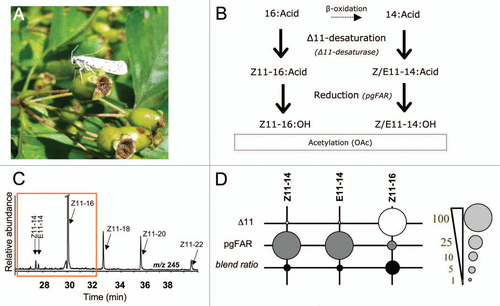Figures & data
Figure 1 Pheromone biosynthesis in Yponomeuta padellus (Lepidoptera: Yponomeutidae). (A) An Yponomeuta moth on hawthorn (Crataegus sp., Rosaceae). (B) Pheromone biosynthetic pathway towards the Δ11-unsaturated components in the Yponomeuta genus. (C) GC-MS analysis of Δ11-monounsaturated fatty-acyl intermediates produced by functional expression of the Ypa-Δ11-desaturase in the YEpOLEX expression vector and the ole 1 elo 1 strain of the yeast Saccharomyces cerevisiae following a procedure as previously described.Citation14 The chromatogram trace represents dimethyl disulfide adducts (DMDS) from methanolyzed yeast extracts. In vitro, the Δ11-desaturase catalyses the introduction of a double bond at the eleventh carbon atom (characteristic ion at m/z 245) in several natural yeast fatty acids from C14 to C22. The Z11-14, E11-14 and Z11-16 acyls are produced in a 1.1:0.8:100 ratio, respectively. (D) The dot areas are proportional (%) to the Δ11-desaturase and pgFAR substrate preferences and to the final ratio between components. The reverse chain-length preference of the Δ11-desaturase and pgFAR for acyl substrates with 14 or 16 carbon atoms allows adjusting the final blend ratio.
